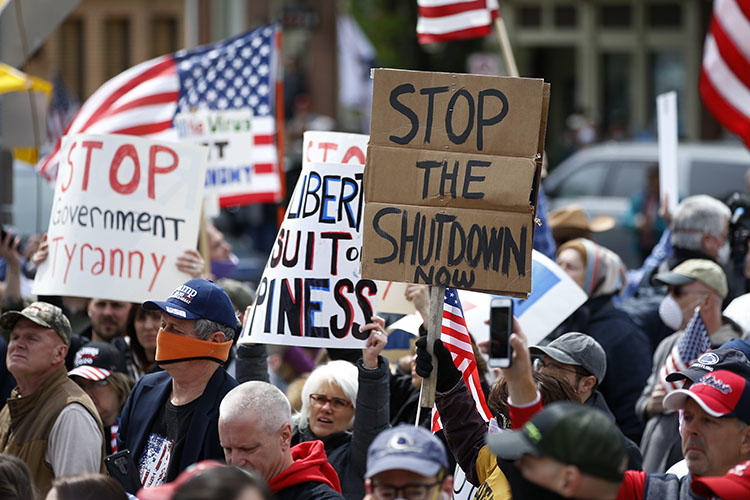Over the past week, protesters have held a series of demonstrations against “shelter in place” restrictions to slow the spread of COVID-19 in more than a dozen U.S. states, according to news reports. There was also a small counter-protest by health care workers in Colorado, as reported by CNN.
Though the demonstrations have been largely peaceful, a protester attacked at knifepoint a FOX 11 news photographer in Huntington Beach, California, demanding that he delete any video that he appeared in, according to a report by the journalist’s employer.
With many demonstrators ignoring physical distancing guidelines, journalists should be aware of the risk of exposure to COVID-19 while covering the protests. Media workers planning to cover the protests should therefore consider the following safety information, and also read CPJ’s regularly updated COVID-19 safety advisory.
Pre-Assignment
● With many newsrooms operating with skeleton staff, there may be a temptation to send individual reporters to cover protests. Assess the risk and if necessary work in pairs or hire a ‘backwatcher’ or security guard, noting the recent knife attack against the FOX 11 photojournalist in California
● Consider who is suitable for the assignment given the ongoing COVID-19 outbreak. Older people and individuals with underlying health conditions are considered high risk, according to the CDC, as well as those who are pregnant
● Also consider the journalists’ ethnicity, noting an increase in hate crimes and racist incidents targeting people of Asian descent, as reported by Al-Jazeera
● Online harassment around COVID-19 reporting could potentially increase as a result of anti-media rhetoric and sentiment, as reported by CPJ. A useful psychological safety guide on how to protect your mental health if you experience online harassment can be found here
● Ensure you have a regular check-in procedure with your management team or office
● Plan the assignment and ensure that the battery on your cell phone is fully charged. Know the area you are going to and work out in advance what to do in the event of an emergency
On Assignment
● Remain alert to the risk of people spitting / coughing close to or on you, either accidentally or deliberately. Ensure you maintain a minimum distance of at least 2 meters with everybody at all times
● The CDC recommends that people wear a cloth face covering to cover their nose and mouth, though a better quality N95 mask (or FFP2 / FFP3) is preferable. Strict adherence to face mask safety is essential
● When working in or close to a crowd, plan a strategy. Try to keep to the outside of the crowd and avoid the middle, where it is hard to escape. Identify all possible escape routes
● Wear clothing and footwear that allow you to move swiftly. Avoid wearing necklaces, ponytails, lanyards or anything that can be grabbed, as well as flammable material, such as nylon
● Use long sight lenses to help maintain a safe distance on location, as well as directional ‘fishpole’ microphones instead of clip mics. Wherever possible use mobile equipment rather than those with cables. Please see the CPJ COVID-19 safety advisory for more information
● Take regular breaks and be mindful of fatigue and energy levels, taking into account that tired individuals are more likely to make mistakes with hand washing and hygiene routine
● Consider your position. Try to find an elevated position that may offer greater safety
● Maintain situational awareness at all times and limit valuables in your possession such as jewelry and watches. Do not leave any equipment or other valuable items in vehicles
● Continually monitor local sources for news of any location-specific movement restrictions in place
● If the police decide to break up a protest, and/or protests turn violent, be aware of the dangers posed by crowd control measures such as kettling and/or the use of tear gas
● At any location, always plan and identify an evacuation route. If working with others, select an emergency rendezvous point
If faced with aggression:
● Read body language and use your own body language to pacify a situation
● Keep eye contact with an aggressor, use open hand gestures and keep talking with a calming manner
● Keep an extended arm’s length from the threat. Back away and if someone grabs hold of you, break away firmly without aggression. If cornered and in danger, shout
● If the situation escalates, keep a hand free to protect your head and move with short, deliberate steps to avoid falling. If in a team, stick together and link arms
● Be aware of the situation and your own safety. While there are times when documenting aggression can be newsworthy, taking pictures of aggressive individuals can escalate a situation
For additional information and tools for pre-assignment preparation and post-incident assistance, visit CPJ’s Resource Center.
